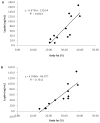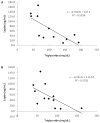Long-term exercise training in overweight adolescents improves plasma peptide YY and resistin - PubMed (original) (raw)
Clinical Trial
. 2009 Jun;17(6):1189-95.
doi: 10.1038/oby.2009.11. Epub 2009 Feb 26.
Affiliations
- PMID: 19247279
- PMCID: PMC3845441
- DOI: 10.1038/oby.2009.11
Clinical Trial
Long-term exercise training in overweight adolescents improves plasma peptide YY and resistin
Terry E Jones et al. Obesity (Silver Spring). 2009 Jun.
Abstract
The objective of this study was to investigate the effect of long-term exercise training on concentrations of five hormones related to appetite and insulin resistance in overweight adolescents. In addition, we were interested in the relationships of these hormones with each other and with anthropometric and/or cardiovascular disease marker changes. Participants were >or=the 85th percentile for BMI for age and sex and participated in an 8-month supervised aerobic training program. Anthropometrics, cardiovascular fitness assessment, and fasting blood samples were taken pre- and post-training. Glucose, insulin, total cholesterol (TC), high-density lipoprotein (HDL) cholesterol, low-density lipoprotein (LDL) cholesterol, triglycerides, leptin, active ghrelin, total peptide YY (PYY), adiponectin, and resistin concentrations were measured. The participants increased their time to exhaustion on an incremental treadmill test and decreased both percent body fat and blood triglyceride concentrations. Total PYY concentration increased and resistin concentration decreased after long-term exercise training, which are favorable outcomes. Leptin concentrations were related to weight, percent body fat, waist circumference, and triglyceride concentrations pre- and post-training. The changes in resistin concentrations were related to the changes in triglyceride concentrations. We conclude that long-term exercise training has beneficial effects for overweight adolescents with respect to PYY and resistin, hormones related to appetite and insulin sensitivity.
Conflict of interest statement
Disclosure
The authors declare no conflict of interest.
Figures
Figure 1
Relationship of changes in fasting triglyceride concentrations and changes in fasting resistin concentrations with long-term exercise training (p ≤ 0.05, 95% confidence interval (0.004, 0.065)).
Figure 2
Relationships between percent body fat and leptin concentrations (A) pre-training (p ≤ 0.001, 95% confidence interval (3.539, 9.820)) and (B) post-training (p ≤ 0.001, 95% confidence interval (2.661, 6.132)).
Figure 3
Relationships between triglyceride concentrations and leptin concentrations (A) pre-training (p ≤ 0.01, 95% confidence interval (−1.242, −0.282)) and (B) post-training (p ≤ 0.05, 95% confidence interval (−1.449, −0.073)).
Similar articles
- Impact of Resistance and Endurance Training on Ghrelin and Plasma Leptin Levels in Overweight and Obese Subjects.
Mitoiu BI, Nartea R, Miclaus RS. Mitoiu BI, et al. Int J Mol Sci. 2024 Jul 24;25(15):8067. doi: 10.3390/ijms25158067. Int J Mol Sci. 2024. PMID: 39125635 Free PMC article. Review. - Lactation and appetite-regulating hormones: increased maternal plasma peptide YY concentrations 3-6 months postpartum.
Vila G, Hopfgartner J, Grimm G, Baumgartner-Parzer SM, Kautzky-Willer A, Clodi M, Luger A. Vila G, et al. Br J Nutr. 2015 Oct 28;114(8):1203-8. doi: 10.1017/S0007114515002536. Epub 2015 Aug 24. Br J Nutr. 2015. PMID: 26299586 - Exercise training during normobaric hypoxic confinement does not alter hormonal appetite regulation.
Debevec T, Simpson EJ, Macdonald IA, Eiken O, Mekjavic IB. Debevec T, et al. PLoS One. 2014 Jun 2;9(6):e98874. doi: 10.1371/journal.pone.0098874. eCollection 2014. PLoS One. 2014. PMID: 24887106 Free PMC article. Clinical Trial. - Association of cardiac changes with serum adiponectin and resistin levels in obese and overweight children.
Aknc A, Karakurt C, Gurbuz S, Elkran O, Nalbantoglu O, Kocak G, Guldur T, Yologlu S. Aknc A, et al. J Cardiovasc Med (Hagerstown). 2013 Mar;14(3):228-34. doi: 10.2459/JCM.0b013e328351674e. J Cardiovasc Med (Hagerstown). 2013. PMID: 22441215 - Effects of exercise intensity on plasma concentrations of appetite-regulating hormones: Potential mechanisms.
Hazell TJ, Islam H, Townsend LK, Schmale MS, Copeland JL. Hazell TJ, et al. Appetite. 2016 Mar 1;98:80-8. doi: 10.1016/j.appet.2015.12.016. Epub 2015 Dec 22. Appetite. 2016. PMID: 26721721 Review.
Cited by
- Weighted vest intervention during whole-body circuit training improves serum resistin, insulin resistance, and cardiometabolic risk factors in normal-weight obese women.
Kim J, Kim E, Kim D, Yoon S. Kim J, et al. J Exerc Sci Fit. 2024 Oct;22(4):463-473. doi: 10.1016/j.jesf.2024.10.002. Epub 2024 Oct 22. J Exerc Sci Fit. 2024. PMID: 39525516 Free PMC article. - The Effect of a Multidisciplinary Lifestyle Intervention Program on Apelin-12, Vaspin and Resistin Concentrations in Children and Adolescents with Overweight and Obesity.
Karampatsou SI, Paltoglou G, Genitsaridi SM, Kassari P, Charmandari E. Karampatsou SI, et al. Nutrients. 2024 Oct 26;16(21):3646. doi: 10.3390/nu16213646. Nutrients. 2024. PMID: 39519480 Free PMC article. - Aerobic exercise elevates perceived appetite but does not modify energy intake over a 3-day postexercise period: A pilot study.
Okada TE, Jeromson S, Rathwell S, Wright DC, Bomhof MR. Okada TE, et al. Physiol Rep. 2024 Sep;12(18):e70066. doi: 10.14814/phy2.70066. Physiol Rep. 2024. PMID: 39328151 Free PMC article. Clinical Trial. - Impact of Resistance and Endurance Training on Ghrelin and Plasma Leptin Levels in Overweight and Obese Subjects.
Mitoiu BI, Nartea R, Miclaus RS. Mitoiu BI, et al. Int J Mol Sci. 2024 Jul 24;25(15):8067. doi: 10.3390/ijms25158067. Int J Mol Sci. 2024. PMID: 39125635 Free PMC article. Review. - Prevention Is Better than Cure-Body Composition and Glycolipid Metabolism after a 24-Week Physical Activity Program without Nutritional Intervention in Healthy Sedentary Women.
Śliwicka E, Popierz-Rydlewska N, Straburzyńska-Lupa A, Nikolov J, Pilaczyńska-Szcześniak Ł, Gogojewicz A. Śliwicka E, et al. Nutrients. 2024 Aug 2;16(15):2536. doi: 10.3390/nu16152536. Nutrients. 2024. PMID: 39125415 Free PMC article.
References
- Hedley AA, Ogden CL, Johnson CL, Carroll MD, Curtin LR, Flegal KM. Prevalence of overweight and obesity among US children, adolescents, and adults, 1999–2002. JAMA. 2004;291:2847–2850. - PubMed
- Dabelea D, Bell RA, et al. Writing Group for the SEARCH for Diabetes in Youth Study Group. Incidence of diabetes in youth in the united states. JAMA. 2007;297:2716–2724. - PubMed
- I’allemand D, Wiegand S, Reinehr T, et al. Cardiovascular risk in 26,008 european overweight children as established by a multicenter database. Obesity (Silver Spring) 2008 - PubMed
- Kelley GA, Kelley KS. Efficacy of aerobic exercise on coronary heart disease risk factors. Prev Cardiol. 2008;11:71–75. - PubMed
- Goodyear LJ, Kahn BB. Exercise, glucose transport, and insulin sensitivity. Annu Rev Med. 1998;49:235–261. - PubMed
Publication types
MeSH terms
Substances
LinkOut - more resources
Full Text Sources
Miscellaneous


